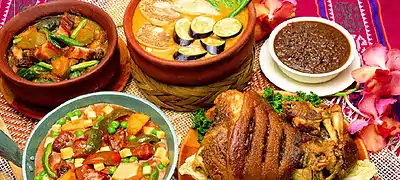_-_Philippines.jpg.webp) Ginataang kalabasa with shrimp, yardlong beans, and eggplant | |
| Alternative names | Kalabasa sa gata, Nilatik na kalabasa, Squash in coconut milk, Kabasi ha gata Pinggata a babasal |
|---|---|
| Course | Main course |
| Place of origin | Philippines |
| Serving temperature | Hot |
| Main ingredients | calabaza, coconut milk |
Ginataang kalabasa, also known as kalabasa sa gata, is a Filipino vegetable stew made from calabaza in coconut milk and spices. It commonly includes shrimp and yardlong beans and either bagoong (fermented fish or shrimp) or patis (fish sauce). It can also be cooked with fish, crab, or meat and a variety of other ingredients. It is a creamy umami-laden dish that is naturally slightly sweet due to the calabaza. It is a type of ginataan.[1]
Names
Ginataang kalabasa is found throughout the Philippines and is known under a variety of names. It is usually anglicized as "squash in coconut milk." It is also known as dinuldog in Cebuano,[2] kalabasa sa gata in Tagalog, kabasi ha gata in Tausug, pinggata a babasal in Maguindanao and nilatik na kalabasa in Hiligaynon. The names can also change depending on the secondary ingredient, like ginataang kalabasa at hipon when shrimp is added, or ginataang kalabasa at sitaw when yardlong beans are added.[3][4][5]
In some versions, the secondary ingredient is treated as the main ingredient, although they are still just variations of ginataang kalabasa. Examples include ginataang alimango (mud crabs) and ginataang alimasag (blue crabs), both of which still include calabaza.[6][7][8]
When multiple vegetable ingredients are used, the more generalized term ginataang gulay ("vegetables in coconut milk") is also used to refer to the dish.[9]
Description
The basic recipe for ginataang kalabasa includes cubed calabaza (kalabasa, commonly known in Philippine English as "squash"), coconut milk (gata), coconut cream (kakang gata), ginger, onions, garlic, and either bagoong (fermented fish or shrimp) or patis (fish sauce), and salt and pepper to taste. For convenience, some modern versions substitute the shrimp paste or fish sauce with monosodium glutamate or commercial granulated seasoning. The garlic and onions are first sautéed in oil on a pan, then the coconut milk with the rest of the ingredients are added. It is cooked in low heat until the squash becomes very tender. The coconut cream is added last and cooked in low heat with constant stirring until the broth thickens.[10][11][12][13]
Variants
The dish is easily modified which results in multiple variants. The most common secondary ingredients for ginataang kalabasa are yardlong beans cut into five-centimetre (2.0 in) lengths and shrimp. Fish, crab, or meat (usually pork) can also be used. A spicy version is also common with the addition of siling haba and/or labuyo. Other ingredients can include moringa leaves (malunggay), tomatoes, squash blossoms, eggplant, and okra, among others.[11][5][12][14][15] The calabaza can be substituted with butternut squash or kabocha, especially in western versions.[16]
A vegan or vegetarian version of the dish can also be created by using mushroom sauce in place of fish sauce or shrimp paste and leaving out the meat and seafood.[17]
Ginataang kalabasa is differentiated from other types of ginataan which may also use similar ingredients like ginataang hipon (shrimp in coconut milk) and ginataang ampalaya in that the latter dishes do not include calabaza.[18]
See also
References
- ↑ Baes, Patricia. "The Flavors of Ginataang Kalabasa Makes Our Filipino-Style Hummus Shine". Pepper.ph. Retrieved April 19, 2019.
- ↑ Lachica, Immae (January 4, 2020). "Find the best squash to make the best dinuldog". Cebu Daily News. Retrieved April 25, 2021.
- ↑ "Kalabasa & Sitaw sa Gata a la Marketman". Market Manila. Retrieved April 19, 2019.
- ↑ "Ginataang Kalabasa with Hipon". Lola Kusinera. Retrieved April 19, 2019.
- 1 2 "Ginataang Kalabasa with Shrimp and Malunggay Recipe". Casa Baluarte Filipino Recipes. Retrieved April 19, 2019.
- ↑ "Crabs in Coconut Milk (Ginataang Alimango)". Foxy Folksy. Retrieved April 19, 2019.
- ↑ "Ginataang Alimango". Maputing Cooking. Retrieved April 19, 2019.
- ↑ "Ginataang Alimasag". Recipe ni Juan. Retrieved April 19, 2019.
- ↑ "Ginataang Gulay (Vegetables Simmered in Coconut Milk)". Filipino Recipes Lutong Pinoy. Retrieved April 19, 2019.
- ↑ Dagoon, Jesse D.; Dagoon, Aida L.; Dagoon, Jasmin Flora L. (1999). Culinary Arts I. Rex Bookstore, Inc. ISBN 9789712326035.
- 1 2 Comsti, Angelo (2015). Fuss-free Filipino Food: Quick & Easy Dishes for Everyday Cooking. Marshall Cavendish International Asia Pte Ltd. p. 14. ISBN 9789814721851.
- 1 2 "Ginataang Kalabasa (Squash with Coconut Milk)". Panlasang Pinoy Meaty Recipes. Retrieved April 19, 2019.
- ↑ "Pork Ginataan with Squash and String Beans". Panlasang Pinoy. Retrieved April 19, 2019.
- ↑ "Sugpo, Kalabasa at Sitaw sa Gata a la Marketman". Market Manila. Retrieved April 19, 2019.
- ↑ Gonzalez, Marie. "Ginataang Gulay Recipe". Yummy.ph. Retrieved April 19, 2019.
- ↑ "Ginataang Sitaw at Kalabasa (Squash and String Beans in Coconut Cream Sauce)". Ang Sarap. Retrieved April 19, 2019.
- ↑ Enriquez, R.G. "Squash and Long Beans in Coconut Milk". Astig Vegan. Retrieved April 19, 2019.
- ↑ "Gintaang Hipon (Prawns in Coconut Milk)". Busog! Sarap!. Retrieved April 19, 2019.
